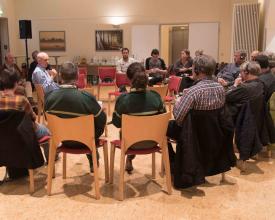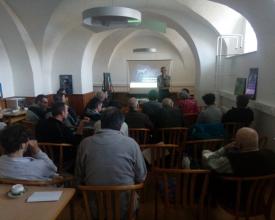

L'un des objectifs de la nouvelle charte du Parc Naturel Régional des Vosges du Nord est d'assurer un suivi continu des espèces caractéristiques de certains habitats des Vosges du Nord (rochers, forêts, vergers, cours d'eau, zones humides). La charte vise également à travailler au renforcement de la population de lynx et à son acceptation par les habitants, à l'échelle transfrontalière.
Le parlement du lynx réunit tous les acteurs concernés par le lynx sur le territoire du Parc. Ainsi, chaque acteur a fait des propositions pour améliorer l'acceptation du lynx.
Contexte
Défis à relever
Le principal défi est la résolution d'un conflit entre les différentes parties prenantes.
Emplacement
Traiter
Résumé du processus
La médiation avec les chasseurs est l'une des priorités fixées par le parlement du lynx. Les chasseurs sont informés de l'avancement des opérations de réintroduction dans le Palatinat au même titre que les parlementaires. Le Parc rend compte au Parlement de l'avancement des actions de médiation avec le secteur de la chasse. Les représentants des chasseurs étant membres du Parlement, l'information circule bien. Il y a un lien étroit entre ces deux projets.
Blocs de construction
Mise en place d'un parlement pour améliorer l'acceptation du lynx
Deux médiateurs professionnels ont travaillé avec un groupe de 20 personnes avec une approche participative et des jeux de rôle, le respect de la parole de chacun et la transparence de l'information. Quatre réunions d'une journée ont été nécessaires pour aboutir à un livre blanc de propositions de chaque acteur pour améliorer l'acceptation du lynx.
Ces propositions ont été transmises aux organisations / responsables pour une éventuelle négociation, validation et mise en œuvre. Le parlement se réunit annuellement et le Parc en est le coordinateur et met en œuvre ses engagements.
Facteurs favorables
Le parc est reconnu pour son rôle de facilitateur et le lynx est relâché chez nos voisins allemands. Malgré cela les avis sont opposés selon les acteurs et l'ambiance parlementaire est apaisée car il y a respect de la parole de chacun et l'instauration d'un climat de confiance.
Leçon apprise
Le niveau d'engagement est variable selon les membres du parlement. Le parc joue un rôle central en tant que coordinateur et modérateur du parlement. Son niveau d'engagement est important.
Il maintient la cohésion du parlement et l'intérêt de ses membres en envoyant régulièrement des informations sur les lynx relâchés dans la forêt du Palatinat. La transparence des informations sur le lynx contribue à renforcer la protection de la vie privée des membres du parlement.
Travailler avec les chasseurs pour éviter le braconnage du lynx
Plusieurs réunions d'information ont été organisées pour les chasseurs, ce qui a permis de maintenir un groupe de travail sur les relations entre la chasse et le lynx. Un projet de médiation avec les chasseurs des Vosges du Nord pour améliorer l'acceptation du lynx est en cours. Les objectifs de cette médiation sont d'éviter tout acte de braconnage, d'améliorer l'acceptation du lynx par les chasseurs et de sensibiliser à la gestion globale de la forêt.
Facteurs favorables
Une étude sociologique sur les représentations du lynx par les chasseurs. L'étude a été menée auprès d'un large panel de personnes. Cette étude a montré que même si une majorité de chasseurs ont des craintes vis-à-vis du lynx pour le chevreuil, les nouveaux chasseurs sont prêts à l'accepter pour chasser l'image de la chasse.
Leçon apprise
Ce travail avec les chasseurs a montré qu'il faut travailler à deux niveaux : une médiation individuelle avec le maximum de chasseurs locaux et une médiation avec les représentants des associations pour voir en quoi le lynx est une opportunité ou un risque.
Impacts
Les parties prenantes se réunissent au moins une fois par an pour suivre la mise en œuvre des engagements de chacun. Ces réunions annuelles ou extraordinaires ont pour but d'initier le dialogue en offrant un espace d'échange et de communication, dans le respect de chacun, entre les représentants des chasseurs, les scientifiques et les gestionnaires de parcs, sur les lâchers de lynx en particulier, mais aussi sur les mises à jour du programme LIFE. Parfois, des scientifiques sont également invités à présenter leurs travaux sur le lynx ou sur d'autres sujets. Chaque session est également l'occasion d'évaluer les progrès des engagements de chaque membre, et d'inviter les différents médias à s'informer sur le lynx pour une communication plus large. Tout cela contribue à établir la transparence dans le partage de l'information, ce qui est un autre objectif important du Parlement.
Chaque membre de cette structure de gouvernance présente des propositions, qui sont d'abord validées par les autres membres. Celles qui sont approuvées sont ensuite soumises au Préfet, représentant régional de l'Etat français, par les autorités du Parc.
Bénéficiaires
Chasseur, agriculteur, forestier, utilisateur de la forêt, élu local, ONG environnementale











